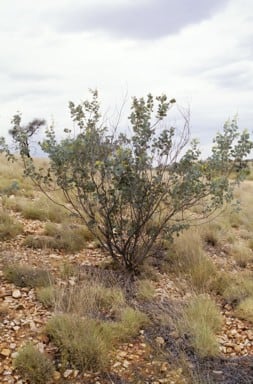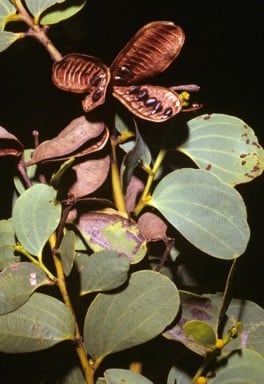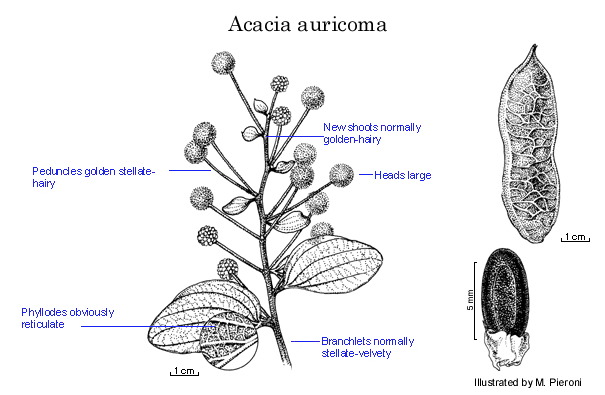Acacia auricoma Maslin
WATTLE
Acacias of Australia
Common Name
Alumaru, Nyalpilintji or Petermann Wattle
Family
Fabaceae
Distribution
Occurs at Anne Ra., W.A., and E from Bloods Ra. to the Petermann Ra., N.T.
Description
Rather straggly shrub 1.5–3 m high. Branchlets terete, minutely stellate-velvety, rarely glabrous. New shoots usually golden-hairy. Stipules 1–1.5 mm long. Phyllodes inequilaterally elliptic, 3–10 cm long, 1.5–4 cm wide, rotund-obtuse, coriaceous, subglaucous, usually minutely stellate-velvety, with 3–5 raised main nerves (some confluent with lower margin for c. 1 cm above pulvinus), prominently reticulate; gland basal, with 2–4 additional glands in shallow notches along upper margin. Inflorescences simple but forming terminal ‘false’ racemes by phyllode suppression; peduncles mostly 2 per axil, 15–30 mm long and golden stellate-hairy, stout, furrowed; heads globular, 7–8 mm diam., densely 100–135-flowered, golden. Flowers 5-merous; sepals 1/4–1/2-united, with lobes densely golden-puberulous; petals apically golden-puberulous. Pods narrowly oblong, ±flat, to 8 cm long, 15–25 mm wide, firmly chartaceous to thinly coriaceous, transversely reticulate, stellate-puberulous; margins narrowly winged. Seeds transverse, oblong to elliptic-oblong, 5.5–6.5 mm long, dull, dark brown; aril terminal.
Habitat
Grows in skeletal soil on quartzite scree slopes in open shrubland with spinifex.
Specimens
W.A.: near E end of Anne Ra., A.S.George 12094 (PERTH). N.T.: Shaw R., East Petermann Ra., W.H.Butler 7 (PERTH); Mannanana Ra., Petermann Aboriginal Reserve, T.S.Henshall 2146 (PERTH); Livingstone Pass, Docker R., S.J.Midgley 554 (PERTH).
Notes
Most closely related to A. retivenea, which lacks the golden hairy new shoots, peduncles, bracteoles, sepals and petals normally characteristic of A. auricoma; furthermore, A. retivenea has larger stipules and branchlets and phyllodes with a crispate-villous or tomentose indumentum, not minutely stellate-velvety as in A. auricoma. Rare glabrous variants occur in both species. Stellate pubescence occurs also in a few related northern species such as A. flavescens, A. leptoloba and A. sericata, all of which are distinguished by their racemose inflorescences.
One fruiting collection, S.J.Midgley 554 (PERTH), is aberrant in being glabrous throughout but in other respects appears to represent the species.
FOA Reference
Data derived from Flora of Australia Volumes 11A (2001), 11B (2001) and 12 (1998), products of ABRS, ©Commonwealth of Australia
Author
R.S.Cowan, B.R.Maslin
Minor edits by J.Rogers
This identification key and fact sheets are available as a mobile application:
URL: https://apps.lucidcentral.org/wattle/
© Copyright 2018. All rights reserved.










